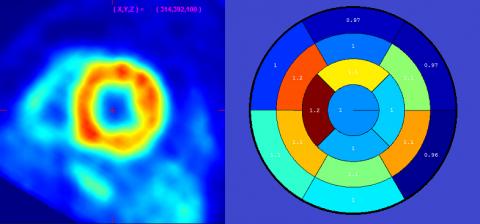Absolute Myocardial Blood Flow
Professors Raymond Muzic, PhD and James O’Donnell, MD, are developing methods for quantifying blood flow in the heart using PET scanning with rubidium-82. The project is funded through the Ohio Department of Development's Third Frontier program with Piotr Maniawski representing Philips Healthcare. Goals of the project are to improve health care and to stimulate Ohio’s economy through job creation. This will be achieved by filling an unmet need. No current clinical PET 3D scanner has sufficient bandwidth to accommodate the event rates seen during the rubidium-82 exam. The project entails hardware revisions to a clinical PET scanner to support higher count rates as well as software to correct for any residual count-losses. In addition, we will develop image reconstruction system that is more than an order-of-magnitude faster than existing system to produce the time-sequence of image volumes that capture the myocardial uptake and washout of tracer. Finally, we will create image analysis and physiologic modeling software along with workflows to determine absolute blood flow in the heart in a clinically relevant manner.
Positron Mammographic Imaging
Positron Mammographic Imaging is a project to develop a first-of-its-kind system that will provide greatly enhanced resolution of Positron Emission Tomography (PET) technology that is used to detect breast cancer through CT or MRI (Magnetic Resonance Imaging) imaging. Using the new PET/MRI at the UH Seidman Cancer Center, one of four in the world, researchers will explore if this hybrid imaging technology enhances the ability to more accurately detect breast cancer. In a new class of diagnostic imaging modalities, the PET/MRI brings together the complementary capabilities of MRI and PET to better visualize both functional and anatomical information. The use of MRI alone to detect breast cancer often leads to false positive results because it picks up benign abnormalities, but combining the images with PET may enhance the ability to detect malignant areas. This greater resolution has the potential to provide physicians with the ability to improve surgical planning and better monitoring of the disease.
Raymond Muzic, PhD, Associate Professor of Radiology, Oncology and Biomedical Engineering at Case Western Reserve University, is the overall project leader. The research team includes Donna Plecha, MD, Director of Breast Imaging and Assistant Professor, James O'Donnell, MD, Director of Nuclear Medicine and Professor, and Peter Faulhaber, MD, Radiologist and Associate Professor, UH Case Medical Center and Case Western Reserve University Department of Radiology, and Piotr Maniawski of Philips.



